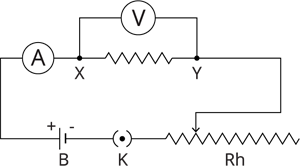PDF chapter test TRY NOW
This experiment requires a coil of wire, a screw gauge, a metre scale, battery, key, ammeter, voltmeter, rheostat and connecting wires.

An electric circuit
Formula:
Procedure:
• Connect the battery, ammeter, wire, rheostat, and key in series, and the voltmeter in parallel to the unknown resistor.
• Close the key.
• Now, adjust the rheostat such that the ammeter reads a current of \(0.5\ A\).
• Note down the potential difference in the voltmeter.
• Again, adjust the rheostat and change the current in steps of \(0.5\ A\).
• For each current, note the corresponding potential difference in the voltmeter.
• Note down the values.
• Using a screw gauge and a metre scale, measure the diameter of the wire and the length of the coil, respectively.
• Connect the battery, ammeter, wire, rheostat, and key in series, and the voltmeter in parallel to the unknown resistor.
• Close the key.
• Now, adjust the rheostat such that the ammeter reads a current of \(0.5\ A\).
• Note down the potential difference in the voltmeter.
• Again, adjust the rheostat and change the current in steps of \(0.5\ A\).
• For each current, note the corresponding potential difference in the voltmeter.
• Note down the values.
• Using a screw gauge and a metre scale, measure the diameter of the wire and the length of the coil, respectively.
Observations:
(i) To find the resistance:
(i) To find the resistance:
| S.No | Ammeter reading- \(I\) (Ampere) | Voltmeter reading- \(V\) (Volt) | Resistance\(=\) \(\frac {V}{I}\) (Ohm) |
| 1. | |||
| 2. | |||
| 3. | |||
| 4. | |||
| 5. | |||
| 6. |
(ii) To find the diameter of the wire using screw gauge:
| S.No | Pitch scale reading(PSR) (\(mm\)) | Head scale coincidence (\(HSC\)) | Head scale reading \(HSR\) \(=\) \({HSC } \times {LC}\) (\(mm\)) | Total reading \(=\) \(PSR + HSR\) (\(mm\)) |
| 1. | ||||
| 2. | ||||
| 3. |
From the observed data, the resistivity of the material of the wire can be found using the formula.
To know more about screw gauge, click here.
